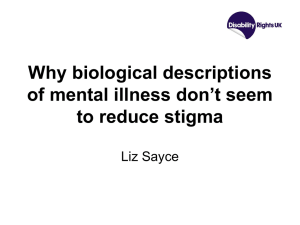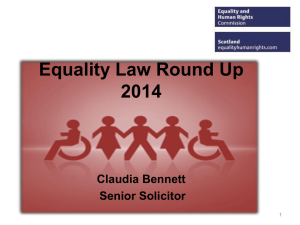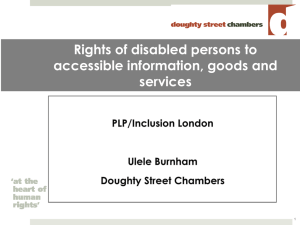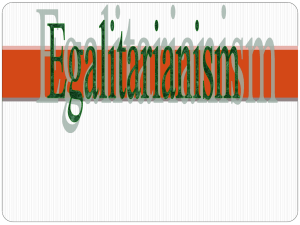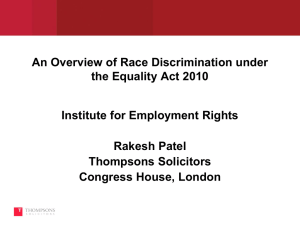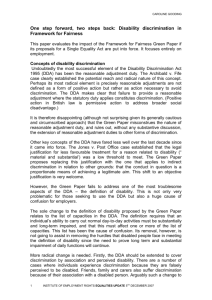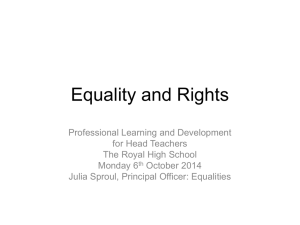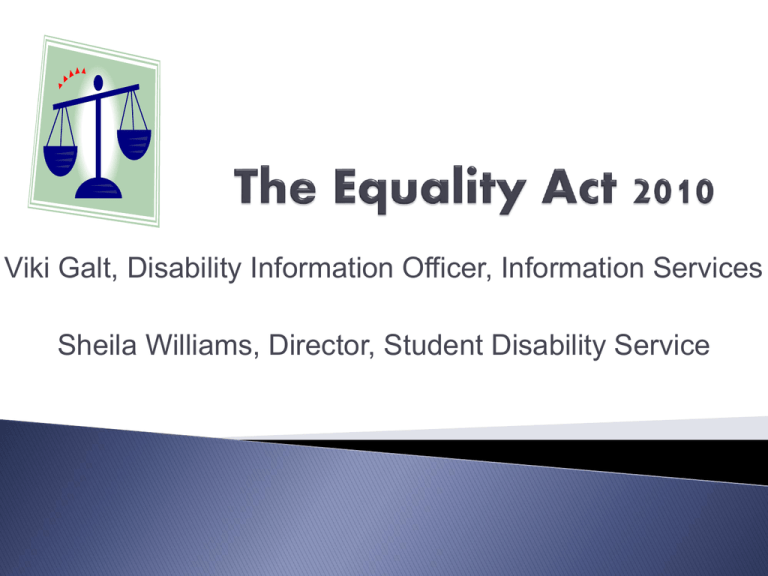
Viki Galt, Disability Information Officer, Information Services
Sheila Williams, Director, Student Disability Service
The
Equality Act aims to simplify and consolidate
previous anti discrimination laws such as the DDA,
Sex Discrimination Act etc
Replaces Disability Discrimination Act and the
Disability Equality Duty
Most of the act came into effect October 2010
Covers 9 protected characteristics
Age
Disability
Race
Religion/belief
Gender/sex
Gender reassignment
Pregnancy and maternity
Marriage and civil partnership
Sexual orientation
A person has a disability if:
they have a mental or physical impairment
- and it has a substantial and long term adverse
effect on their ability to carry out normal day to day
activities
-
Slightly different from DDA as no list of capacities.
Substantial – more than minor or trivial
Long term – more than 12 months
Medical treatment – effect of disability without medication
Recurring and progressive conditions – specific provisions
Passported conditions – sight impairments, HIV, cancer,
Multiple Sclerosis
Exclusions – hayfever, non prescribed drug addiction,
alcohol addiction, tendency to set fires, steal, exhibitionism,
voyeurism, tendency to physical or sexual abuse of others.
Who?
- All Higher education institutions
- Staff, students, potential staff and students
- Visitors if meet definition
-
-
What?
Pretty much everything!
Admissions, exclusions, Library services and
policies, computer facilities, cafes, research
facilities, the physical environment etc
-
Direct Discrimination
Now includes discrimination by perception and
association
combined discrimination
Indirect Discrimination
Harassment
Victimisation
Discrimination arising from a Disability
Failure to make reasonable adjustments
Direct Discrimination
- Where A treats B less favourably because they are
disabled
- Now includes discrimination by association and by
perception
-
Indirect Discrimination
Where a practice, policy or procedure is applied to
everyone and puts disabled people at a disadvantage
And this can’t be shown to be a proportionate means
of achieving a legitimate aim
Discrimination arising from Disability
-
Where A discriminates against B because of
something arising in consequence of B’s disability
and cannot be shown as a proportionate means of
achieving a legitimate aim.
-
Harassment
-
Where A harasses B if A engages in unwanted
conduct related to B’s disability which violates B’s
dignity or creates a intimidating, hostile,
degrading, humiliating or offensive environment
Victimisation
- Where a subjects B to a detriment because A does
a protected act or A believes that B has done or
may do a protected Act.
Necessary to maintain academic standards
Necessary to maintain other prescribed standards
Is of a prescribed type
Occurs in a prescribed circumstance
Reasons are both material to the circumstances of
the particular case and substantial
-
Failure to make reasonable adjustments
Three requirements:
1. Where a provision, criteria or practice puts a disabled
person at a substantial disadvantage there is a duty to
take reasonable steps to avoid the disadvantage
2. Where a physical feature puts a disabled person at a
substantial disadvantage there is a duty take such
steps to avoid the disadvantage
3. Where a lack of auxiliary aids puts a disabled person
at a disadvantage there is a duty to provide for them
to avoid the disadvantage.
University of Edinburgh: numbers of
students disclosing a disability
University of Edinburgh:
numbers of students disclosing
a disability
-1424 students with active Learning
Profiles
-13055 recommended adjustments
for disabled students
Top ten adjustments
Provide OUTLINE or Powerpoint presentation for lecture/seminar at least
24 hours in advance
1089
Give permission to record lectures
923
25% additional time in examinations
900
Student has SpLDs. S/he should incur no penalties for poor spelling,
grammar, punctuation and structure in examination scripts, unless these
are being directly assessed and are core to an understanding of the course.
836
Provide double loan time on reserve/short loan books
774
Student is permitted to use coursework stickers
724
Student requires prior sight (15 minutes) of the (exam) paper for the
purposes of reading and highlighting
683
Provide reading lists to be ordered by priority/relevance
646
Student not to sit 2 3 hour exams in one day (where possible Registry will
schedule examinations to avoid this; however where not possible, additional
adjustments may be required)
446
Provide copies of any additional written materials used or created in class
411
The student perspective
“Part of my learning profile says that lecturers
are supposed to provide notes. However, many
of them do not think it necessary and sometimes
scoff at being asked to do such a thing.”
Quote from University of Edinburgh
Disability Office Student Evaluation 2009 -10
Case study
The School of Medicine excludes a student with
Asperger Syndrome for saying inappropriate
things to a tutor. The student does this because he
doesn’t realise that he shouldn’t say these things.
The School has excluded other students for
similar behaviour.
Is this discrimination under
the Equality Act?
Case study
A student is admitted to study biochemistry. The student has
dyspraxia and this has a significant impact on her ability to
undertake written work, therefore she has difficulty with maths,
reading and spelling, as well as writing up her experiments.
She is also having problems following instructions, has difficulty with
concentration and is easily distracted. Her poor motor co-ordination
may put other students at risk during practical experiments and she
is finding it difficult to undertake the practical work.
Despite a number of adjustments it is considered that she is not
able to continue on the course as it is not possible for her to
maintain the necessary academic standards.
Is this discrimination under
the Equality Act?
-
-
-
the need to maintain standards
size, resources and nature of the institution
types of services being provided
effect of disability on disabled person
how practical the adjustment is
health and safety
cost of adjustment
extent to which it resolves the issue
relevant interests of other people.
Duty on all public sector bodies including
universities
Comprises General and Specific duties
General duties:
- Public authorities to have due regard to eliminate
discrimination, harassment or victimisation.
- To advance equality of opportunity
- To foster good relations
Specific Duties – situation unclear – single equality
schemes. Impact assessments, employment data
duty, publish equality outcomes



